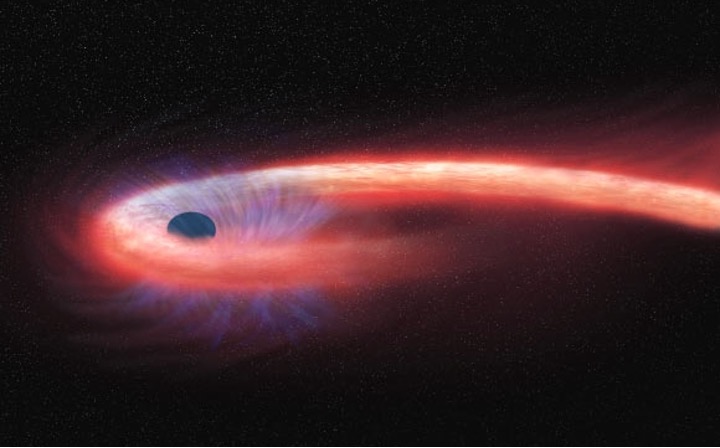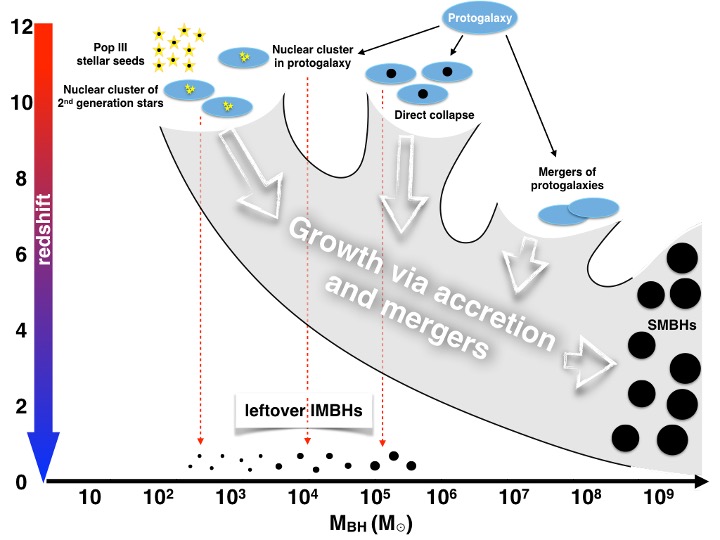A luminous flare provides astronomers with a rare opportunity to measure the mass of an otherwise quiescent black hole at the center of a dwarf galaxy.

NASA / CXC / M. Weiss
Most large galaxies contain supermassive black holes, whose masses can easily exceed a billion times the mass of the Sun. These behemoths have grown through mergers of lower-mass black holes, or seeds, and by devouring surrounding gas. The seeds, many of which dwell in dwarf galaxies, are key to understanding the history of black hole formation. However, they are also difficult to study.
Black holes with between 100 and 1 million solar masses form a class of intermediate-mass black holes (IMBHs). We know these objects abound in dwarf galaxies, but mass measurements exist for only about 20 nearby IMBHs — and most of these measurements are highly uncertain. Therefore, the population of dwarf galaxies’ black holes and their formation mechanisms remain unknown, and reports of new IMBHs are in high demand.
In a recent study, published in Nature Astronomy, Charlotte Angus (University of Copenhagen) and team demonstrated a rather unconventional but potentially powerful method to find and study IMBHs. They report the detection of a tidal disruption event (TDE), a bright flare emitted as a dwarf galaxy’s ripped a star apart. The flare both pointed out the existence of the black hole and enabled the measurement of its mass. This is the first time that scientists have found a TDE in visible light around a dwarf galaxy’s black hole (X-ray-emitting TDEs in dwarf galaxies have been detected but their signatures are more ambiguous).
Rare and Fast Event
Massive black holes tear apart stars that come too close. While some of the stellar gas escapes the clutches of the black hole, the other part swirls around it and forms an accretion disk. In the process, such a tidal disruption event can emit both visible light and X-rays.
On June 17, 2020, the Young Supernova Experiment, a survey dedicated to finding new cosmic explosions just days or hours after the explosion, detected a new light source. The source, cataloged as AT 2020neh, appeared in the center of a dwarf galaxy about 1 billion light years away. The source’s position, its fast brightening followed by a gradual fading, and the properties of its spectrum led the researchers to conclude that they were looking at a tidal disruption event. They found that, to explain the way the brightness changed over time, a black hole with somewhat less than 1 million solar masses must have ripped apart a star of about one solar mass.
TDEs around low-mass black holes ought to be faint. “For a small black hole to produce something that we can see, you need the material to circularize around the black hole fairly quickly,” says Charlotte Angus (Niels Bohr Institute, Copenhagen). “In order to do this, you need to have a plunging encounter, where [the star] comes at a higher angle.” The unique encounter probably contributed to its unusually quick rise in intensity.
IMBHs typically announce themselves by the radiation coming from the gas that they’re accreting from their surroundings. However, most are not surrounded by gas and so remain invisible. The new study has demonstrated a way to uncover these stealthy black holes, which could lead to a better idea of how prevalent IMBHs are in dwarf galaxies.
“We’ve been talking about the promise of TDEs to reveal black hole population in dwarfs for decades,” says Jenny Greene (Princeton University). “The idea that we can search and reliably find these things and then work out all the uncertainties with the rates, I just find this enormously promising.”
Black Hole Seeds

Mar Mezcua
Intermediate-mass black holes could have formed in several ways. As possible scenarios, astronomers propose mergers among stellar-mass black holes, formations in dense star clusters, and a collapse of a large gas clouds. But the relative importance of each scenario remains unclear.
Compared to their more massive counterparts, IMBHs in dwarf galaxies haven't grown much since they formed. Astronomers can therefore use the properties of IMBHs and their observed frequencies in dwarf galaxies to constrain the masses of the black holes seeds as well as their formation mechanisms.
But to do this, astronomers need to ramp up the numbers of known IMBHs. Angus and her team estimate that the Young Supernova Experiment might detect another 5 or 6 events similar to AT 2020neh in the coming three years of operation. Angus emphasizes the power of combining different visible-light surveys, especially when it comes to finding there-and-gone-again events like this one.
Much further down the road, the community awaits the launch of the European Space Agency’s Laser Interferometer Space Antenna (LISA), currently projected for 2037. This space-based gravitational wave detector will be uniquely suited to detecting black holes down to 10,000 solar masses.
 0
0









Comments
You must be logged in to post a comment.